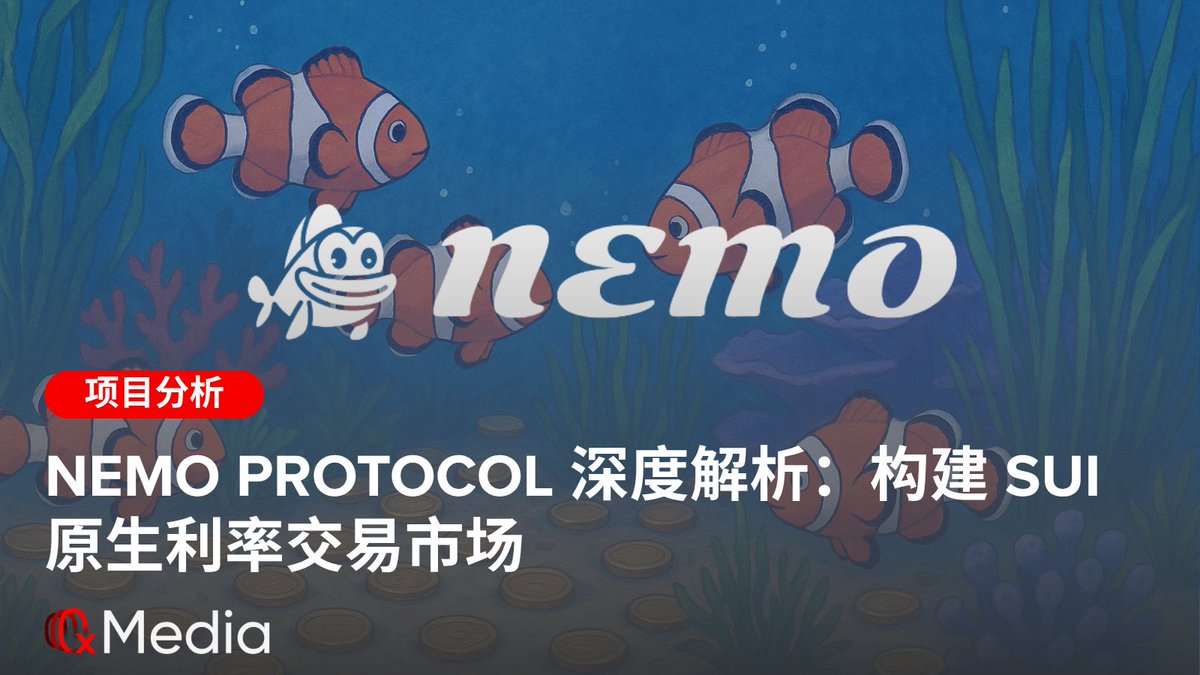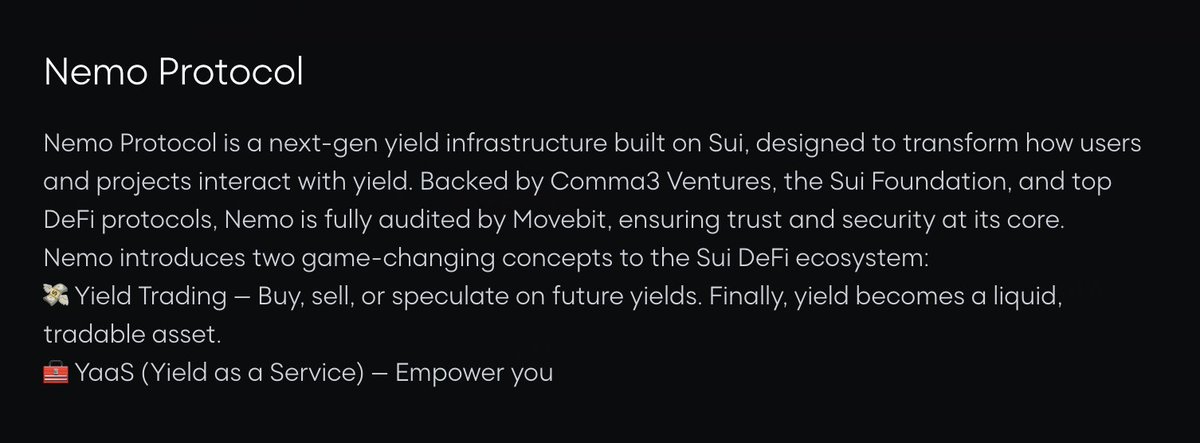🐟 In-depth analysis of Nemo Protocol: Building Sui's native interest rate trading market
With the rapid development of the @SuiNetwork chain in the Layer 1 track, its ecology is gradually improving, but there is still a gap in the yield management and interest rate market. The advent of @nemoprotocol is the key piece of the puzzle to complete this application scenario. It is not only the first PT/YT interest rate protocol deployed on the $SUI chain, but also one of the core carriers for various liquid staking derivatives (LSD) application scenarios. For Defi players, Nemo Protocol, which is still in the early stages of the project, still has many potential high-yield opportunities and gameplay to be explored.
At present, the liquidity pools of the two stablecoins launched by Nemo, sUSDC and ssbUSDT, can bring liquidity providers more than 25% APY and triple points rewards for a limited time under the strong subsidy of the platform ecosystem. Therefore, this article will unfold from the perspective of DeFi investors, deeply analyse the underlying logic and mechanism of Nemo, and help readers grasp its basic income model and deeply participate in Nemo's interest rate trading ecosystem.

1. Overview of the Nemo Project — Introducing Interest Rate Trading Market Logic to the Sui Chain
The core goal of the Nemo Protocol is to bring structured financial instruments of traditional fixed and variable income into the DeFi world. Nemo achieves this by on-chain splitting the principal and yield portions of LSD assets (such as sSUI, sUSDC, ssbUDST, etc.) based on the Sui chain ecosystem, thereby forming tradable PT (Principal Token) and YT (Yield Token). By splitting LSD assets into PT and YT tokens, Nemo provides DeFi users with more options for yield strategies, allowing them to achieve "composability of yield" based on their risk preferences.
Specifically, the Nemo Protocol is positioned as: a native interest rate trading protocol on the Sui chain + a platform for financializing LSD yields, while also serving multiple roles as a yield prediction market, interest rate trading platform, arbitrage tool, and structured investment product platform.
As of now, according to data from @DefiLlama, the total locked value of the Nemo Protocol has reached $3.07M, temporarily ranking 27th on the Sui chain. The current main pool's TVL has already taken shape, with a total locked value exceeding $2.5M across the three major pools: sUSDC, ssbUSDT, and sSUI. Among the top thirty protocols by TVL on the Sui chain, Nemo is the only project focusing on the "interest rate splitting + yield financialization" track, filling a gap in the Sui ecosystem in this field.
2. Project Team and Funding Background
Although the specific information about the project team has not been fully disclosed, based on public activities, code quality, and community operations, Nemo is led by a team with strong DeFi technical expertise that is deeply involved in the construction of the Sui native ecosystem. Nemo has already received official recognition from the Sui Foundation in its early stages and has entered the ecological incubation program, with its architectural design highly aligned with Sui's characteristics, showcasing a distinct chain-native style.
At the same time, according to the project introduction on the @Galxe official website, the Nemo Protocol has received investments and support from Comma3 Ventures (@comma3vc) and @SuiFoundation. Additionally, the project has undergone a smart contract audit by @MoveBit_ and has issued an audit report. As of now, the Nemo Protocol's smart contracts continue to operate stably, with no significant vulnerabilities.

3. Introduction to the Core Mechanism of the Project
1. What are PT (Principal Token) and YT (Yield Token), and how is the separation of PT and YT achieved?
- PT (Principal Token): Represents the principal of the staked assets, and holders can redeem their original assets at a 1:1 ratio upon the expiration of the agreement. Essentially, it is a discounted subscription "future principal certificate," suitable for conservative investors who prefer to lock in returns.
- YT (Yield Token): Represents ownership of future earnings. Holders can receive real-time actual LSD earnings (such as staking rewards from sSUI) during the holding period. The price of YT is determined by the market's expected yield, resembling a "floating coupon" of fixed-income products.
- The specific separation method is as follows:
First, after users deposit LSD assets (such as sSUI) into Nemo's smart contract, the smart contract will convert the LSD assets into SY (standardized yield assets). Next, the smart contract calculates the principal portion of the assets and the future potential earnings based on preset yield rules and market interest rates, and mints an equal amount of PT and YT to distribute to users. Users can choose to hold, trade PT, YT, or add liquidity.
4. Introduction to the Core Mechanism of the Project
2. How can investors navigate PT and YT, and what are the returns and risks of purchasing PT or YT?
▶️ The first option is to purchase PT: Lock in future principal and earn the discount spread.
Source of returns: PT is typically issued at a discount to the original LSD asset price, for example, the price of 1PT-sUSDC is 0.9681 $USDC. After holding PT until maturity, the holder can redeem it for 1 LSD, thus obtaining a fixed return. The fixed yield of this investment in terms of cryptocurrency is = 1 / the price at which the investor purchased the PT token. Under normal circumstances, investors holding PT until maturity can reliably recover their principal and achieve stable returns.
Risk points: Although the strategy of holding PT tokens is very stable, it still faces specific risks. From the perspective of cryptocurrency, as long as the PT token is held until maturity, there is no risk of loss for the investor. However, from the perspective of USD, the returns on PT tokens will also be affected by price fluctuations of the LSD asset.
If the market experiences significant volatility and the price of the LSD asset falls, then the principal and returns redeemed at maturity for PT may not cover the losses caused by the depreciation of the asset value in USD terms. Of course, if the LSD asset itself is a stablecoin with a stable price, such as sUSDC, then investors do not need to worry about the loss risk in cryptocurrency terms.
Suitable audience: Conservative investors who prefer risk-free arbitrage.
▶️ The second option is to purchase YT: Speculate on future yield increases and participate in yield volatility arbitrage.
Source of returns: Investors holding YT have the right to receive investment returns. As the assets in the investment pool generate actual returns (including tokens and points), these returns will accumulate on YT according to certain distribution rules and be distributed to YT holders. During the continuous distribution of returns over time, the value of YT tokens will gradually decrease and ultimately reach zero on the maturity date.
It is important to note that when calculating the yield of YT, one must consider not only the direct returns from asset staking but also the potential airdrop expectations represented by the points for a comprehensive assessment. If the overall yield of the LSD asset staking improves in the future, investors can trade YT at a premium, thus earning spread profits.
Risk points: If the future yield of the LSD asset declines, investors will have to bear the losses caused by the drop in YT prices.
Suitable audience: Traders with a unique understanding of the DeFi ecosystem, capable of market prediction and able to assess the volatility of LSD asset APY.
📖 Read more:
0
2.55K
The content on this page is provided by third parties. Unless otherwise stated, OKX is not the author of the cited article(s) and does not claim any copyright in the materials. The content is provided for informational purposes only and does not represent the views of OKX. It is not intended to be an endorsement of any kind and should not be considered investment advice or a solicitation to buy or sell digital assets. To the extent generative AI is utilized to provide summaries or other information, such AI generated content may be inaccurate or inconsistent. Please read the linked article for more details and information. OKX is not responsible for content hosted on third party sites. Digital asset holdings, including stablecoins and NFTs, involve a high degree of risk and can fluctuate greatly. You should carefully consider whether trading or holding digital assets is suitable for you in light of your financial condition.

